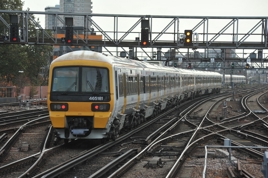Southeastern is inviting five train manufacturers to negotiate to replace “as soon as possible” the operator’s 30-year-old Networker fleet that run metro services in London.
The five companies are Alstom, CAF, Hitachi, Siemens and Stadler. Southeastern said on May 15 that it was “too early to confirm specific designs or principles”, but Managing Director Steve White has supported level boarding.
This will need low-floor trains, with Stadler the only manufacturer with such a train already in UK service (on Merseyrail and Greater Anglia).
“We want customers at Southeastern to be able to travel independently and with confidence,” said White.
“And one of the barriers to achieving that at the moment is the step between the platform and the train. If we could make that level, it would be great news for wheelchair users, for people with buggies, for customers with luggage - it’s just a positive development on a railway.”
Level boarding will need work to Southeastern stations, with White noting that he has more than 200 platforms that vary in height between 500mm and 1,000mm. Railway standards have 915mm as the standard height for platforms.
White said Southeastern would work with Network Rail, train manufacturers, its accessibility panel and the Rail Safety and Standards Board (RSSB) to understand how it could improve level access boarding across its metro network.
Despite the emphasis on new trains with level boarding, Southeastern’s invitation extends to cascading trains from elsewhere or upgrading its current fleet.
The operator wants a fleet with air-conditioning, which Networkers do not have, and with toilets, which its slightly newer ‘376’ fleet (built 2004-05) does not have.
In addition, Southeastern wants to have batteries fitted that are capable of moving the train if third-rail power fails. Without batteries, a power failure leaves trains stranded and raises the risk that passengers alight onto the trackside, which makes restoring power more difficult.
Such an incident occurred at Lewisham in 2018, when ice accumulated on the traction power rail. Power had to be switched off when passengers went onto the track.
The operator expects the replacement fleet to be cheaper to run and more energy-efficient, which it says will reduce taxpayer subsidy and encourage more people to travel by train.
Southeastern’s metro network links London terminals at Victoria, Charing Cross and Cannon Street with south-east London and parts of Kent, including Dartford, Sevenoaks, Grove Park and Gillingham.
The Networker fleet comprises 193 four-car Class 465 and 46 two-car Class 466 electric multiple units. Southeastern uses 170 ‘465s’ and 33 ‘466s’, with the balance stored.
The trains date from 1991-94 and were built in York by BREL/ABB and Birmingham by Metropolitan Cammell/GEC Alsthom. All four companies now sit in Alstom’s history. Ownership is split between Angel Trains and Eversholt Rail.
White said: “Despite the sterling work of our people to keep our current Metro fleets in service, our customers will know only too well that many of the trains are tired and, in terms of accessibility and customer facilities, have fallen behind what is available elsewhere on the Southeastern network and across the country.
Rail Minister Huw Merriman said: “This government continues to back rail manufacturers.
“Today’s announcement demonstrates the UK market is a strong one, supporting high-skilled jobs and boosting the economy right across the country.
“Modernising rolling stock is crucial to delivering a sustainable, reliable and growing rail network, encouraging more people to travel by train. I’m pleased millions of passengers will be able to benefit from this investment for generations to come.”
Southeastern first revealed its ambition to replace its Networkers in November 2022, when it said it wanted 350-570 vehicles, with an option for 70 extra vehicles, to be in service by October 2027 (RAIL 971). It said at the time that invitations to negotiate would be issued before the end of 2023.
















Login to comment
Comments
No comments have been made yet.